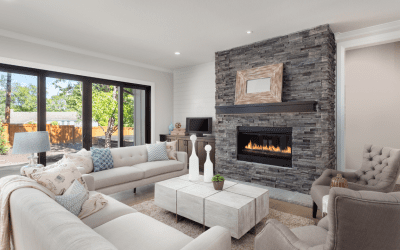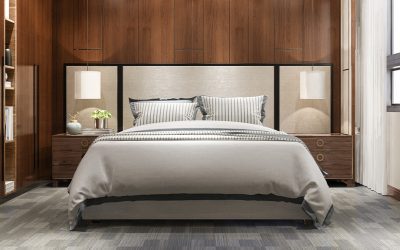Innovative Ideas To Transform Small Space Interior Design
Introduction
When it comes to small spaces, effective interior design techniques can make a world of difference. With the right strategies and creative thinking, you can transform even the most compact areas into functional, stylish, and inviting spaces. In this article, we’ll explore various techniques that will help you optimize your small space interior design and make it feel more spacious and open. From maximizing natural light to utilizing illusions and optical tricks, these design tips will unlock the true potential of your small living area.

Maximizing Natural Light
One of the most powerful effective strategies in small space interior design is by maximizing natural light. Natural light creates an illusion of space and makes a room feel more open and airy. Start by removing any heavy curtains or blinds that obstruct sunlight. Instead, opt for light-filtering or sheer window treatments that allow natural light to flood in while providing privacy. Additionally, keeping windows clean and free of obstacles will ensure maximum light penetration. Consider using light-colored or translucent window coverings to diffuse light and minimize harsh shadows.

Utilizing Mirrors and Reflective Surfaces
Another way to transform small space interior design is to use Mirrors. Mirrors are an interior designer’s best friend when it comes to expanding small spaces. They reflect light and create an illusion of depth, making a room appear larger than it is. Strategically place mirrors opposite windows or sources of light to bounce the light around the room. You can also experiment with mirrored furniture or incorporate reflective surfaces like glass tabletops or metallic accents to further enhance the effect. Remember, the larger the mirror, the more expansive the space will appear.

Choosing the Right Colors
In small space interior design, color plays a crucial role. Light and neutral colors, such as whites, pastels, and soft grays, create an open and airy atmosphere. They reflect light and visually expand the room. Consider painting the walls, ceilings, and trims in the same light color to eliminate visual boundaries and create a seamless look. However, don’t be afraid to introduce pops of vibrant colors through accessories or accent walls to add interest and personality to your space.

Optimal Furniture Placement
In small space interior design, proper furniture placement is crucial. Start by decluttering and only keeping the furniture that serves a purpose. Consider the scale and proportion of each piece to ensure it fits harmoniously within the space. Place furniture against walls to maximize floor space and create a more open flow. Opt for slim-profile furniture with legs to create a sense of lightness and visibility of the floor. Additionally, arranging furniture at angles or in groups can help create distinct zones within the room without compromising space.

Multifunctional Furniture Solutions
In small space interior design, every inch counts. Investing in multifunctional furniture is a smart choice as it maximizes functionality without sacrificing space. Look for furniture pieces that serve dual purposes, such as ottomans with hidden storage, sofa beds, or coffee tables with built-in shelving. These versatile pieces will help you optimize storage options while providing essential functionality for your small space.

Creative Storage Solutions
In small space interior design, storage can often be a challenge. However, with creative solutions, you can effectively utilize every nook and cranny. Look for furniture with built-in storage compartments, such as beds with drawers underneath or ottomans that open up to reveal hidden storage. Floating shelves can be a great addition to small rooms, allowing you to display items while keeping the floor space free. Use vertical storage options like wall-mounted cabinets or hanging organizers to maximize the use of wall space. Don’t forget to declutter regularly and prioritize items that truly serve a purpose.

Incorporating Vertical Space
When horizontal space is limited, it’s time to think vertically. Use your walls to their full potential by incorporating vertical storage solutions, another tip to transform small space interior design is to add hanging plants, or wall-mounted shelves. Consider floor-to-ceiling bookcases or shelving units to make use of vertical space for both storage and display purposes. This not only creates additional storage options but also draws the eye upward, making the room feel more spacious.

Enhancing Visual Depth
In small space interior design Creating visual depth is an effective technique to make small spaces appear larger. Start by choosing a focal point in the room, such as a piece of artwork or a statement piece of furniture. Use layers and textures to add dimension, such as layering rugs or incorporating different fabric textures in upholstery and curtains. Play with patterns and gradients to create an illusion of depth and make the room visually intriguing.

Using Illusions and Optical Tricks
In small space interior design, creating illusions is key to maximizing the perceived space. To make a room appear more spacious, consider using optical tricks. Paint a feature wall with vertical stripes to give the illusion of higher ceilings. Hang curtains slightly above the window frame to make the room seem taller. Opt for furniture with exposed legs to create a sense of openness. These subtle techniques can have a significant impact on the perception of space.

Embracing Minimalism
In small spaces, less is often more. Embrace minimalism and prioritize functionality and simplicity. Declutter regularly to maintain an organized and visually appealing space. Choose furniture with clean lines and minimal ornamentation. Keep decorations and accessories to a minimum, selecting only a few statement pieces that truly enhance the space. By reducing visual clutter, you’ll create an environment that feels open, calm, and spacious.

Balancing Scale and Proportion
When selecting furniture and decor for small space interior design, it’s crucial to maintain a sense of balance. Be mindful of scale and proportion to ensure that each element fits harmoniously. Avoid oversized furniture that overwhelms the room and opt for pieces that are appropriately sized. For example, a large sectional sofa might not be the best choice for a small living room, but a sleek loveseat or a set of compact armchairs can provide comfortable seating without overpowering the space.

Incorporating Textures
To Transform small space interior design use textures. Texture can add visual interest and depth to a small space. Experiment with different textures in your textiles, such as cushions, rugs, and curtains. Incorporate tactile materials like plush fabrics, woven textures, or natural elements such as wood or stone. These textural elements create a sensory experience and make the space feel more inviting and cozy.

Customizing Lighting Options
In small space interior design, lighting plays a crucial role as it greatly influences the overall ambiance. Layering lighting sources can create a warm and inviting atmosphere. Use a combination of ambient lightings, such as overhead fixtures or pendant lights, task lighting for specific areas, and accent lighting to highlight architectural features or artwork. Consider installing dimmers to adjust the light levels and create different moods according to the time of day or the desired ambiance
Conclusion
Transforming small spaces into functional and appealing environments is an art that requires thoughtful small space interior design techniques. By maximizing natural light, utilizing mirrors, choosing the right colors, optimizing furniture placement, and incorporating multifunctional furniture and creative storage solutions, you can make the most out of limited space. Embracing verticality, enhancing visual depth, using illusions and optical tricks, and embracing minimalism will further enhance the perceived spaciousness of the room.
Remember to balance scale and proportion, incorporate textures, and customize lighting options to create a harmonious and inviting atmosphere. With these effective small space interior design techniques, you can transform your small space into a stylish and functional haven that reflects your personal style and maximizes every square inch.
FAQs
- Can I use dark colors in a small space?
While light and neutral colors are generally recommended for small spaces, you can use dark colors strategically. Consider using dark hues as accents or on a single feature wall to create depth and visual interest without overwhelming the space.
- How can I make a small bedroom feel more spacious?
To make a small bedroom feel more spacious, choose a bed with built-in storage or utilize under-bed storage options. Opt for light-colored bedding and curtains to create an airy ambiance. Keep furniture to a minimum and use mirrors to reflect light and create the illusion of space.
- What are some space-saving ideas for a small kitchen?
In a small kitchen, maximize vertical storage by installing wall-mounted shelves or magnetic knife racks. Utilize the inside of cabinet doors for additional storage, hang pots and pans on a ceiling-mounted rack, and invest in compact appliances to save counter space.
- How can I visually divide a small open-plan space?
To visually divide a small open-plan space, use area rugs or different flooring materials to demarcate different zones. Position furniture strategically to create distinct areas for living, dining, and working. Room dividers or folding screens can also provide visual separation when needed.
- Can I incorporate plants in a small space?
Absolutely! Plants can add life and freshness to any space, including small ones. Opt for compact, low-maintenance plants such as succulents or small potted herbs. Hanging plants or wall-mounted planters can save valuable floor space while adding a touch of nature to your small space




0 Comments